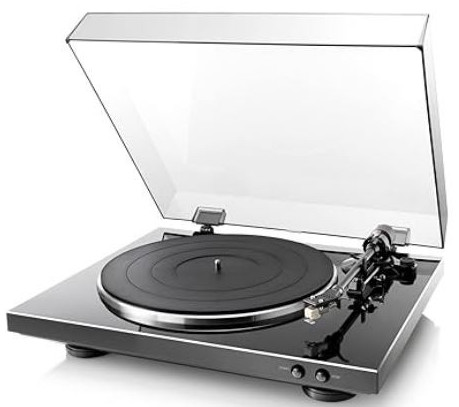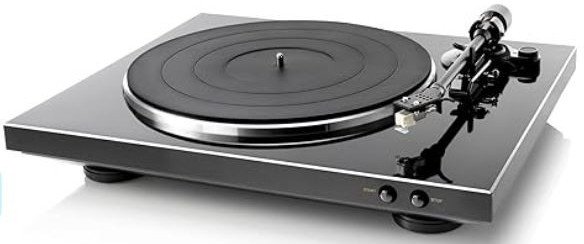As an Amazon Associate, I may earn commissions from qualifying purchases from Amazon.com, Amazon.ca or Amazon.co.uk. This post contains at least one Amazon affiliate link. You can read my Affiliate Disclosure here.

This is a great starter turntable for those with a few more pennies to spend. It probably won’t excite audiophiles, but as a first turntable, it’s a sold buy. The cartridge is replaceable, so as your ears become more discerning, you are able to upgrade without spending big bucks.
Name: DP-300F
Website: Amazon.com
Price: US $399
Manufacturer: Denon
Overall Rank: 4.4/5
The initial setup is not complicated. Playback is automatic. Put the record on the platter and press a button and it does all the work for you. Why, it even returns the tonearm to its starting position when it’s finished. This machine is a real winner for beginners.
Finished with a very dark grey, almost piano-black colour, the Denon DP 300F is a stylish-looking turntable, that’s for sure. That’s probably enough about aesthetics. What about the engineering of the machine?
Well, its plinth (i.e., base) is solid enough, but users do report it picking up vibrations from footsteps and the like. In terms of internal vibrations, the machine is belt-driven so is effectively damped. It has a die-cast aluminium platter.
The tonearm is straight and the headshell is detachable, so different cartridges and styluses can be bought and experimented with until you get the sound that you are more comfortable with.
Regarding speed selection, Denon has not included an option for 78 rpm. That said, switching between 33⅓ and 45 rpm is a breeze – just press the button. To facilitate automatic operation, there is also a button to switch between 7” and 12” records. If you have 10” records, don’t worry as you can manually cue playback.
A preamp is built in, but it can be switched off and an external unit installed. There is a minor issue here in that the on/off button for this is located under the platter. I say it’s a minor issue because if you’ve gone to the trouble and expense of buying an external preamp, you are unlikely to be switching the built-in unit back on once it’s been switched off.

The built-in RCA cable may not be long enough to connect to your speakers. Extending is a non-starter, so you may need to purchase an external preamp plus a longer RCA cable to enable a better connection. A benefit of this may be that electrical interference is reduced.
Turntable features
- Dimensions: 13.8 x 17.1 x 4.7 inches (350.52 x 434.34 x 119.38 mm)
- Weight: 12.1 lbs. (5.5 kgs)
- Finish: Black
- Motor: Belt drive; High torque DC servo motor
- Phono Preamp: Built-In Switchable Phono Preamp
- Power usage: 2 W
- Speeds: 33⅓, and 45 rpm
- Cartridge/Stylus: AT-3600L MM cartridge (5g) with a DSN-85 stylus (2g of pressure); headshell weight 10g
- Platter: Anti resonance, die-cast aluminium with rubber mat
- RCA: 42” stereo RCA cable, fixed
- Power cord: 72”, fixed
- USB: No
- Bluetooth: No
- Operation: Auto stop and auto return; can be operated manually
- Grounding: Internal, no external grounding lug
- Speed change: Push-button
Included accessories
- 45 RPM spindle adapter
- counterweight for accurate tonearm tracking
- hinged dust cover
Special Features
- Hologram Vibration Analysis
- Anti-skating
Playback
So, how does the Denon DP 300F get on when delivering sound to you?
It is equipped with an Audio-Technica AT AT-3600L cartridge and Denon’s own DSN-85 stylus. These are not at the high end of the quality range, but the unit is not at the high end of the price range either. There is a lack of definition at both ends of the aural spectrum. If we’re being really picky, high frequencies lack definition and bass sounds dull. Consequently, cymbals lack their characteristic ‘glassy’ sound and pianos don’t quite ‘tinkle’; the bass doesn’t quite move you as it should.
For beginners, the sound quality will be just fine. You’re likely not to have the most expensive speakers on the block anyway. Furthermore, the cartridge can be replaced so sound reproduction with this turntable can be improved.
As for the routine of listening, you need to set the speed and the record size by pressing the handy buttons. Next, set the disc on the platter and press play. Simples.
Don’t be tempted, however, to dance and prance around the room, especially if you have wooden flooring. It’s not the heaviest and although internal efforts have been made to reduce vibrations, external sources may result in jumps and skips.
Another potential weakness of this machine is the lack of a USB connection. This is likely to not be too great an issue, especially if you want to rip newer records because many nowadays come with a code to download MP3 copies. On the other hand, if you have a copy of PeeWee the Piccolo you desperately want to copy, you will need to consider another option.
Pros and cons
|
Pros |
Cons |
|
|
Conclusion
For those who want no more than to listen to their records without having to set the stylus down in the right place, or even have to touch the tonearm, then this is a machine you should consider strongly. Listeners not wanting to mess around with a raft of fiddly knobs and buttons or not wanting to digitize their collection should also give it serious consideration.

Audiophiles will argue that the sound quality is a bit of a letdown. On the face of it, that’s pretty important. However, we don’t live in a turntable utopia, more’s the pity. Choices and tradeoffs have to be made. For better sound, you must make the trades, e.g., between automatic and manual operation. And, hey, if you are an audiophile, and therefore more discerning, surely you have a lot more cash to spend?
For the price, the Denon DP-300F is on par with other entry-level turntables in terms of performance but outdoes them in terms of features. While there are cheaper automatic turntables, the big plus point of this machine is the tonearm and the ability to change the factory-fitted cartridge and stylus.
If you have enjoyed this article or have anything you would like to add to the debate, please leave me a comment below.

This turntable post brings back great memories of playing records with my friends as a teen. We used to buy the 45 singles every time a new song came out and just about wore the record out.
I recently gave my old Sony turntable to my brother who collects vinyls, and I am going to ask him to check this one out as it is a little more modern than the old Sony and I like that the needle goes back to the start position automatically once the record is done. I must admit that I far prefer CDs and sticks, as I don’t miss all those scratched records we had to force our ears to come acclimatized to.
Thank you for your comment Michel.
As with any purchase like this, you really have to do your research. I’d reiterate that this machine is a solid beginner’s turntable. The sound quality is a little lacking, but only if you are an audiophile. Most users are listening to the lyrics or trying to enjoy what the music makes them feel rather than how much like cymbals the cymbals sound. The automatic operation is a real boon.
Good luck to your brother if he does decide to invest in a new machine, whether it is this one or any other on the market.
Simon
This was a very good review about purchasing this entry level turntable. I especially like the pros and cons. I find reviews with these help me to research quickly and evaluate what I want. I still call turntables “record players” and my records LP’s and 45’s even though now “vinyl” is the popular term. I’m so glad I kept my original albums even though my family says I save too many things. I like the way the original albums sound even though digital is cleaner. It just sounds more “real” to me on the original record media. I’m glad “turntables” are making a comeback and I can share my albums with my now 30 something adult children. Thanks for the review.
Thank you, Delois. Please do not let anybody tell you that you have too many 45s! That’s just not a thing in my book.
You are right, we didn’t call them vinyl back in the day, they were just records or singles or LPs or 45s etc.
Simon